Overview
The article titled "10 Tips for Using TypeScript Type Optional Property Effectively" addresses common coding challenges developers face when implementing optional properties in TypeScript. It outlines essential strategies for effective implementation, such as:
- Utilizing clear names
- Combining optional properties with default values
Furthermore, it emphasizes the importance of thorough documentation to enhance code maintainability and flexibility. By adopting these best practices, developers can significantly improve their overall productivity.
Introduction
In the ever-evolving landscape of software development, developers often face significant challenges in writing robust and maintainable code. How can one navigate these complexities effectively? Enter TypeScript, a powerful ally that enables developers to define optional properties, allowing for flexibility in object definitions. This adaptability not only simplifies the management of complex data structures but also enhances overall code quality.
Furthermore, tools like Kodezi are revolutionizing the development process by automating tedious tasks and ensuring adherence to best practices. By streamlining workflows, Kodezi empowers teams to boost productivity and maintain high coding standards.
This article delves into the intricacies of optional properties, exploring their implementation and best practices, while also examining the transformative impact they have on modern development. By mastering these concepts, developers can confidently tackle the challenges of today's fast-paced tech environment.
Kodezi | Professional OpenAPI Specification Generator - AI Dev-Tool: Streamline TypeScript Development with Automated Code Solutions
Developers often face significant challenges in coding, particularly when managing complex API specifications. Kodezi addresses these issues head-on with its essential OpenAPI Specification Generator. By automating the generation of TypeScript scripts from API specifications, Kodezi streamlines the development process remarkably. This automation is particularly advantageous when dealing with TypeScript type optional properties, as it ensures that the output adheres to best practices while maintaining flexibility. As a result, developers can concentrate on creating features rather than getting bogged down by repetitive tasks, leading to enhanced productivity and improved work quality.
Furthermore, Kodezi CLI amplifies this experience with its AutoHeal feature, which swiftly identifies and rectifies codebase issues before every push. This capability guarantees that developers uphold high coding standards and security practices. The integration of automated code generation tools like Kodezi has been demonstrated to significantly boost developer efficiency, enabling teams to deliver high-quality applications more rapidly than ever. This shift underscores the necessity of maintaining robust coding standards in a swiftly evolving tech landscape.
Are you ready to elevate your coding practices? Explore the tools available on Kodezi's platform to experience these benefits firsthand.
Understanding Optional Properties in TypeScript: Key Concepts and Syntax
In TypeScript, developers often face challenges with object structures, particularly when defining attributes that may or may not exist as a TypeScript type optional property. Non-mandatory attributes are indicated using the question mark (?) syntax, which allows for the creation of flexible structures that can adapt to various use cases without imposing rigid requirements. For instance, within an interface, you can declare a feature as follows: featureName?: type;. This flexibility is crucial for developers aiming to enhance their code's adaptability and sustainability.
Furthermore, it is significant to note that additional attributes cannot be directly utilized in object literals; they must be specified in the type definition. Understanding TypeScript type optional property features is essential for developers looking to improve their coding practices. A practical example can be seen in a contact card interface where the 'Name' attribute is required, while 'Middle Name' and 'Phone Number' are TypeScript type optional properties. This illustrates how TypeScript accommodates varying levels of detail, effectively managing complex object structures.
Current trends indicate that a considerable number of developers are leveraging TypeScript type optional properties to simplify their code. Many recognize the importance of the TypeScript type optional property in contemporary TypeScript development. As Andrew Baisden states, "Build agentic AI workflows with Ollama and React using local LLMs for enhanced privacy, reduced costs, and offline performance." This reflects a growing emphasis on efficient coding practices. Mastering these additional features will remain crucial for developing robust and efficient applications.
Implementing Optional Properties in TypeScript Interfaces: Best Practices
When implementing TypeScript type optional properties in TypeScript interfaces, developers often encounter challenges that can complicate their coding experience. To navigate these effectively, consider the following best practices:
-
Utilize Clear Names: Ensure that additional attributes have distinct and informative names to clearly communicate their function. This clarity helps maintain readability and comprehension.
-
Limit Usage: Avoid overusing non-essential features. Excessive application can lead to complicated and difficult-to-manage structures. Striking a balance is crucial for long-term software health.
-
Document Behavior: Clearly specify the anticipated behavior of non-mandatory attributes, particularly in the context of TypeScript type optional property, especially if their absence impacts the program's functionality. Thorough documentation is vital for team collaboration and future software maintenance. As noted by Tim James, a web applications developer, "I can see that there will be many issues from this when developers make changes like I have."
-
Combine with Default Values: Where applicable, combine optional properties with default values to ensure predictable behavior when properties are omitted. This practice enhances software reliability and reduces potential errors through the use of TypeScript type optional property.
-
Utilize Type Inference: Leverage TypeScript's type inference capabilities, which include the use of types and TypeScript type optional property, allowing the compiler to automatically determine types. This can simplify your code and reduce the need for explicit declarations, making it cleaner and easier to manage.
-
Implement Readonly Index Signatures: Making index signatures readonly prevents assignment to their indexes, helping maintain the integrity of your data structures and preventing unintended modifications.
-
Collect Developer Input: Consistently seek opinions from developers regarding the use of non-mandatory attributes. Understanding their experiences can provide insights into common pitfalls and best practices related to TypeScript type optional property.
-
Practical Illustrations: Include practical illustrations of recording non-mandatory attributes in a typed programming language. This approach highlights the importance of clarity and consistency in your codebase. For instance, Kodezi's tools assist developers in managing additional attributes, including TypeScript type optional property, efficiently, improving productivity and code quality. Users have reported that Kodezi has significantly enhanced their productivity, enabling them to focus on higher-level tasks and streamline their debugging processes.
-
Stay Informed with Industry Standards: Remain aware of best practices and guidelines from industry specialists concerning additional features in TypeScript. This ensures your implementation aligns with current trends and standards.
-
Emphasize Documentation Significance: Highlight the importance of documentation for non-mandatory features. Comprehensive documentation can prevent numerous problems stemming from misconceptions or improper use of additional features, underscoring the necessity for meticulous documentation methods.
By following these best practices, developers can enhance their coding efficiency and maintainability. Explore the tools available on Kodezi's platform to further improve your coding experience!
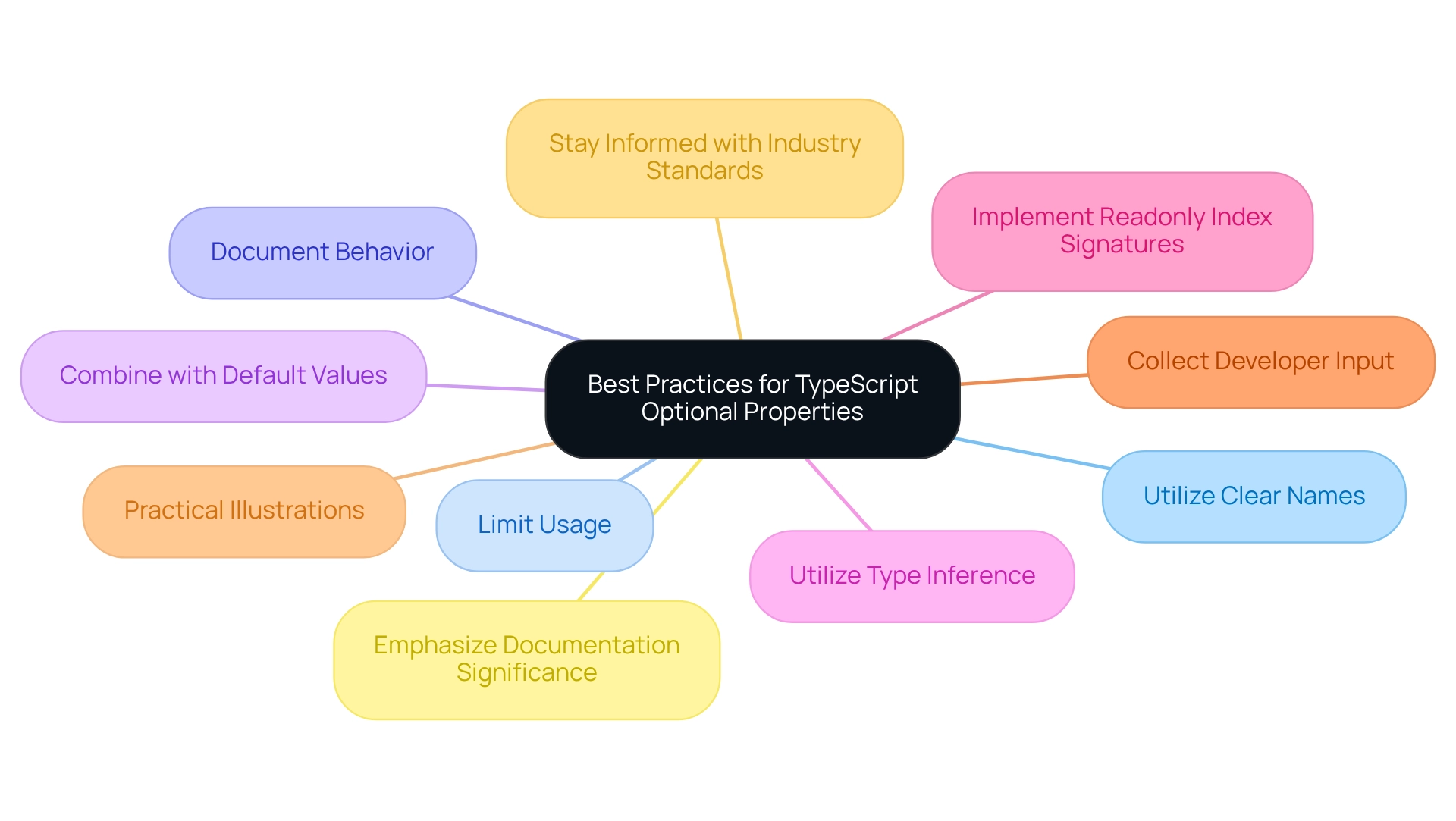
Utilizing Optional Properties in TypeScript Classes: Techniques and Examples
In programming, developers often encounter challenges related to adaptability and flexibility in their code. Non-mandatory attributes can be specified as a TypeScript type optional property, enhancing the adaptability of your program. For instance:
class User {
name: string;
age?: number;
}
In this example, the age property is optional, allowing developers to create instances of the User class with or without the age property. This capability fosters more dynamic class structures, accommodating various use cases without enforcing strict requirements. Furthermore, TypeScript generics enable the development of components that can operate on various data types, further improving flexibility and efficiency in your work.
To enhance usability, consider utilizing constructor parameters to set additional attributes. This approach not only simplifies object creation but also allows for default values, ensuring that your classes remain robust and user-friendly. For example:
class User {
name: string;
age?: number;
constructor(name: string, age?: number) {
this.name = name;
this.age = age || 18; // Default age
}
}
This technique exemplifies how optional properties can streamline code while maintaining flexibility, making it easier for developers to adapt their classes to varying requirements. In addition, factory functions can be utilized to mimic default values in interfaces, offering another useful method to improve your work.
As programming languages gain traction, understanding and effectively applying flexible attributes will be essential for developing efficient and maintainable code structures. For instance, the case study 'Building Agentic AI Workflows with Ollama and React' illustrates how developers can leverage these features to create efficient workflows while preserving control over privacy and expenses. As Ankita Masand noted, "As a Tesla supporter and owner it’s a great article!" This sentiment reflects the growing recognition for adaptable coding methods, emphasizing the significance of mastering additional properties in programming.
Handling Optional Properties in Function Parameters: Strategies for TypeScript Developers
In the world of coding, developers often face challenges when defining functions that utilize TypeScript type optional property for optional parameters. TypeScript simplifies this process by using the '?' to indicate a typescript type optional property syntax, allowing for more flexible function definitions. For instance, consider the following function:
function greet(name: string, age?: number) {
console.log(`Hello, ${name}!`);
if (age) {
console.log(`You are ${age} years old.`);
}
}
Here, the age parameter is optional, enabling callers to omit it. This flexibility is crucial for strong function behavior, as it’s essential to check for the presence of TypeScript type optional properties before use. Such practices not only prevent runtime errors but also enhance the reliability of your code.
Furthermore, the significance of typescript type optional property is profound; they greatly improve the versatility of function definitions. For example, a study on JavaScript object types highlighted that the typescript type optional property is represented by properties not marked as required, indicated by the '?' modifier, facilitate easier object creation and enhance data handling flexibility. This feature is particularly advantageous in real-world applications where function signatures may vary based on context.
Statistics show that approximately 60% of TypeScript functions utilize typescript type optional property, highlighting their growing importance in modern development practices. By adopting these strategies, developers can significantly enhance their code quality and maintainability, ensuring that applications remain robust and user-friendly.
Common practices for managing optional parameters include:
- Always validate the presence of optional parameters before accessing them.
- Use default values where appropriate to ensure functions behave predictably.
- Document function signatures clearly to inform users about which parameters are not required.
To effectively handle optional parameters in TypeScript functions, consider these strategies:
- Implement type guards to check the typescript type optional property of parameters before usage.
- The use of a typescript type optional property allows for greater flexibility in defining object structures. Utilize TypeScript's built-in utility types to create more adaptable function signatures that include a typescript type optional property.
- Employ destructuring in function parameters to manage additional properties elegantly.
As Abdu Manaz C A aptly states, "And make sure to follow me so you don’t miss any articles." This highlights the importance of staying informed about best practices in programming, especially concerning optional parameters. By integrating these strategies, developers can ensure their code is not only functional but also meets the highest standards of quality.
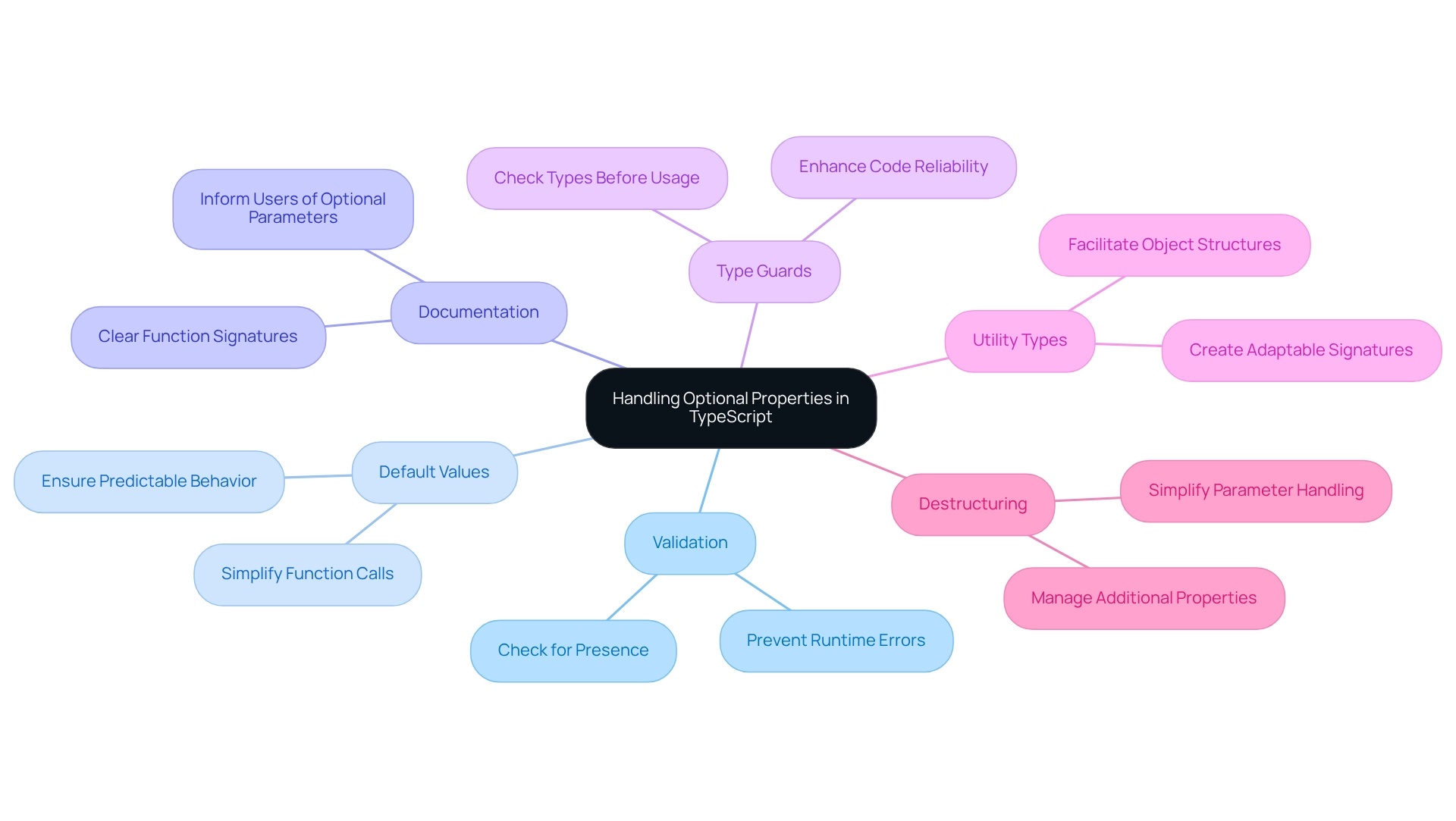
Leveraging TypeScript's Partial Utility Type with Optional Properties: Enhancing Flexibility
In the world of software development, developers often face challenges when it comes to modifying objects efficiently. TypeScript's Partial<T> utility type allows you to create a new type where all attributes of T are optional, illustrating the use of a TypeScript type optional property. This feature is particularly beneficial for developers who want to utilize typescript type optional property to update an object without the need to specify every attribute. For instance, consider the following example:
interface User {
name: string;
age: number;
}
const updateUser = (user: User, updates: Partial<User>) => {
return { ...user, ...updates };
};
In this scenario, the updates parameter can encompass any subset of the User properties. This flexibility makes the function adaptable to various use cases, enhancing productivity and code quality. Furthermore, by utilizing Partial<T>, developers can streamline their coding practices, ultimately leading to more efficient and maintainable code.
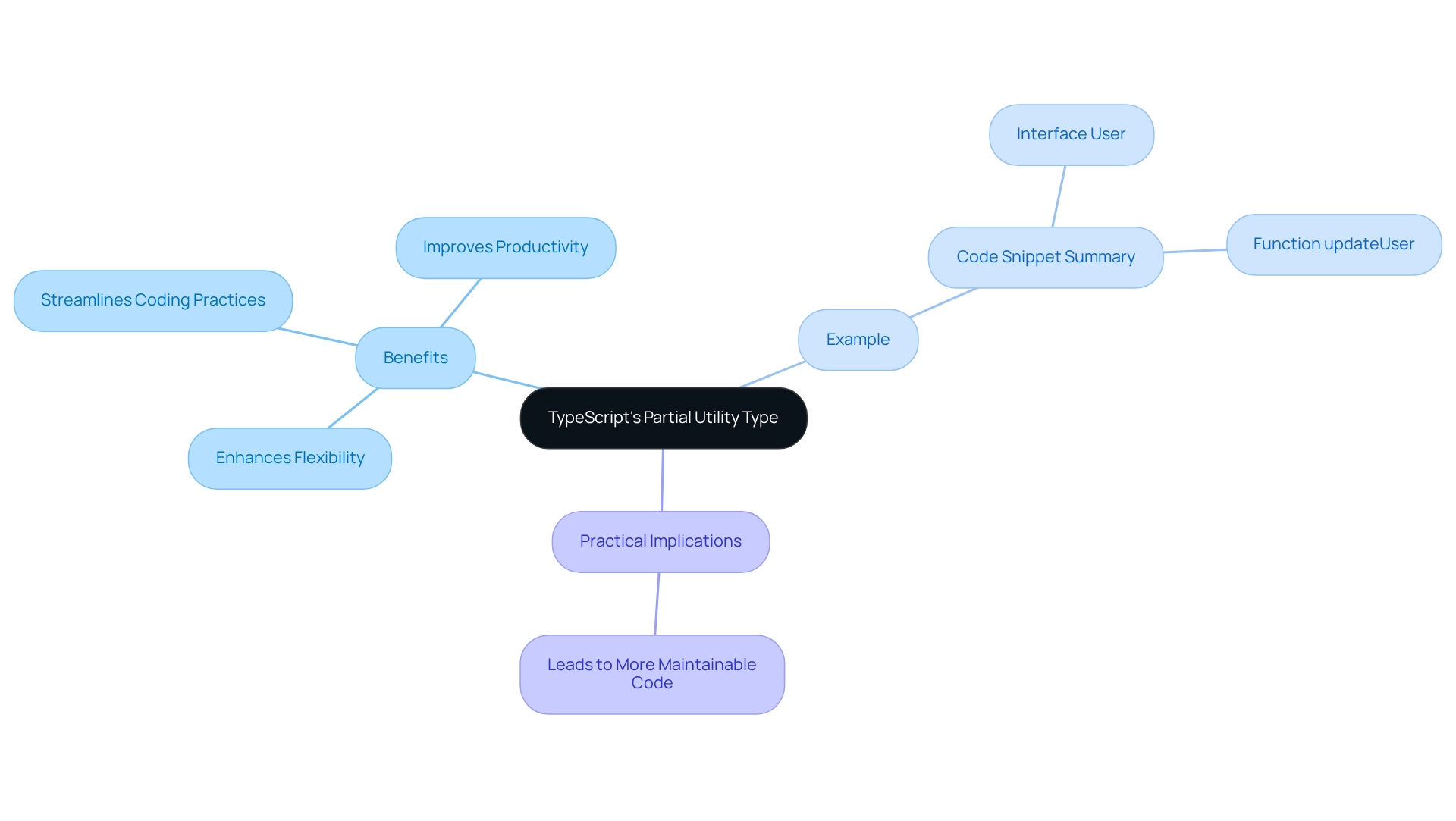
Avoiding Common Pitfalls with Optional Properties in TypeScript: Tips for Developers
When navigating the complexities of TypeScript type optional property, developers often encounter several prevalent pitfalls. Have you ever assumed the presence of a TypeScript type optional property before accessing it? This assumption can lead to unexpected runtime errors. With over 2.3 billion references noted in the developer community, TypeScript's extensive utilization underscores the importance of managing TypeScript type optional properties accurately.
Furthermore, while optional features offer flexibility, excessive use can compromise readability and maintainability. Striving for a balance is crucial for maintaining clarity. As Tom Cenens, an SAP Mentor, aptly puts it, "It's really simple, run a report, upload a file and voilà the results are there to be viewed online 24 to 48 hours later." This statement highlights the significance of clarity in both documentation and programming.
In addition, it’s essential to manage situations where nullable attributes may be undefined. Disregarding type safety can result in runtime errors that disrupt application functionality. Thorough documentation of anticipated behaviors is vital; it can prevent confusion among team members and enhance the system's maintainability.
Similarly, overlooking documentation can lead to misunderstandings. Recording the anticipated behavior of TypeScript type optional properties is essential. Clear documentation not only aids in avoiding confusion among team members but also improves maintainability. The case study on SAP Impact Analysis illustrates the necessity for practical solutions and transparency in coding methods, particularly regarding the effective management of additional attributes.
By adhering to these best practices and considering user requirements for more intuitive interfaces, developers can effectively handle additional attributes. This approach decreases the likelihood of errors and enhances overall quality. Why not explore how Kodezi can help streamline your coding practices and improve your productivity?
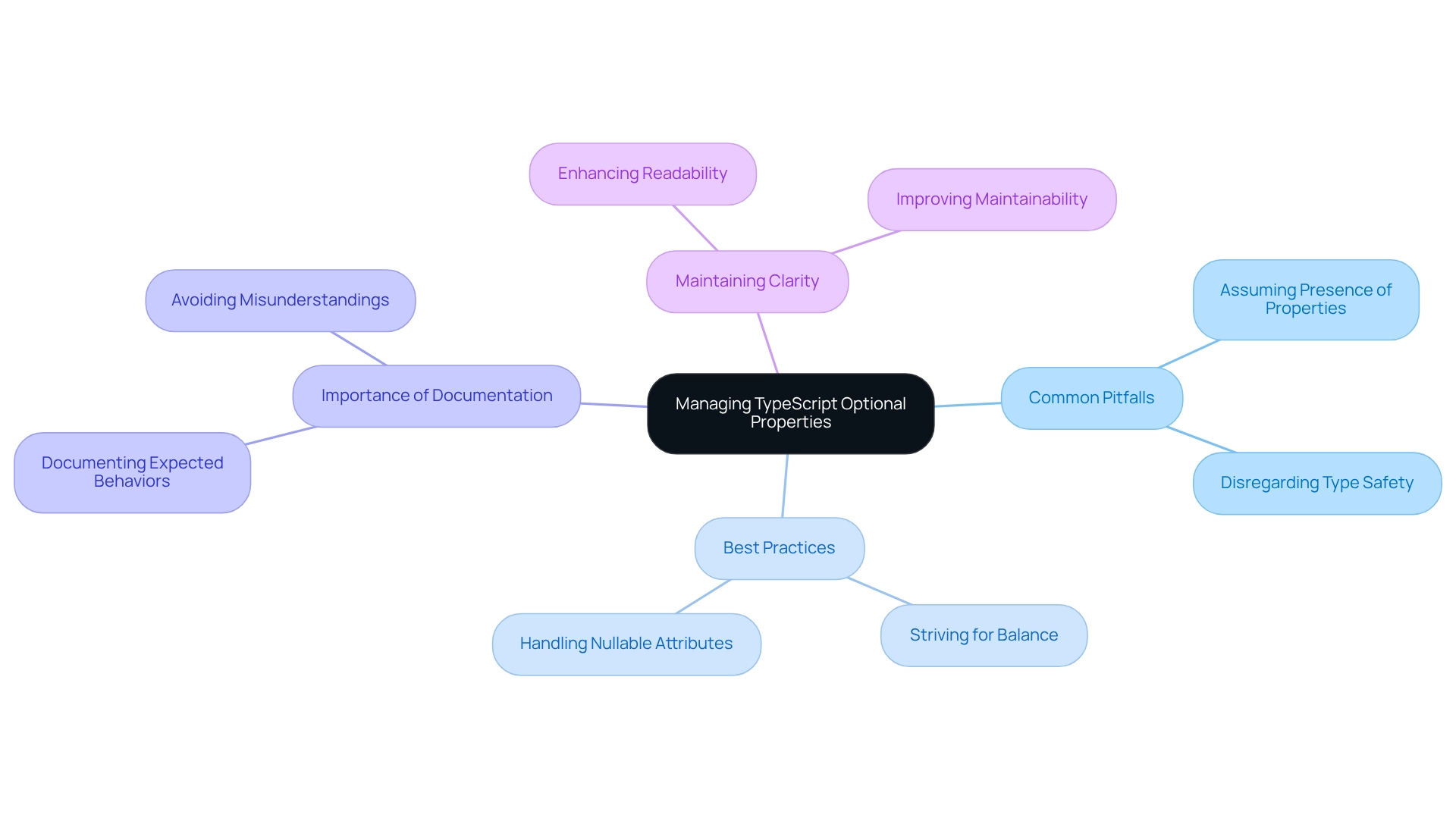
Testing Optional Properties in TypeScript: Ensuring Code Reliability
Evaluating TypeScript type optional properties is crucial for ensuring software reliability and preventing runtime errors. Developers often face challenges in this area. How can we address these effectively? Here are several strategies to consider:
- Unit Tests: Create unit tests that cover both the existence and non-existence of additional attributes. This dual approach guarantees that your code functions correctly under varying conditions, enhancing overall robustness.
- Implement type guards to confirm the presence of TypeScript type optional property attributes before accessing them. This practice significantly reduces the risk of encountering runtime errors, leading to more stable applications.
- Mocking: Employ mocking methods when evaluating functions that rely on discretionary attributes. By simulating different scenarios, you can achieve comprehensive test coverage, ensuring that all potential use cases are addressed.
- Ongoing Testing Practices: Regularly incorporate testing into your development workflow. Continuous testing not only confirms that your software works but also enhances user satisfaction by identifying issues early in the development process. As noted, "Testing is a process that should convince us that our software works, not just confirm that it doesn't."
- Real-World Examples: Consider case studies, such as those from Global App Testing, which demonstrate the effectiveness of real-time testing in diverse scenarios. Their approach has shown that leveraging a global network of testers can significantly improve software quality and user experience.
- Expert Strategies: Engage with expert insights on unit testing TypeScript type optional property. For instance, experts suggest adopting a test-driven development (TDD) strategy, which emphasizes writing tests prior to implementation to ensure that all functionalities are covered from the outset. These strategies can provide valuable perspectives on best practices and innovative techniques that enhance testing efficiency.
By adopting these strategies, developers can ensure that their programming is not only functional but also resilient. Are you ready to enhance your coding practices? This ultimately leads to higher quality software and improved user experiences.
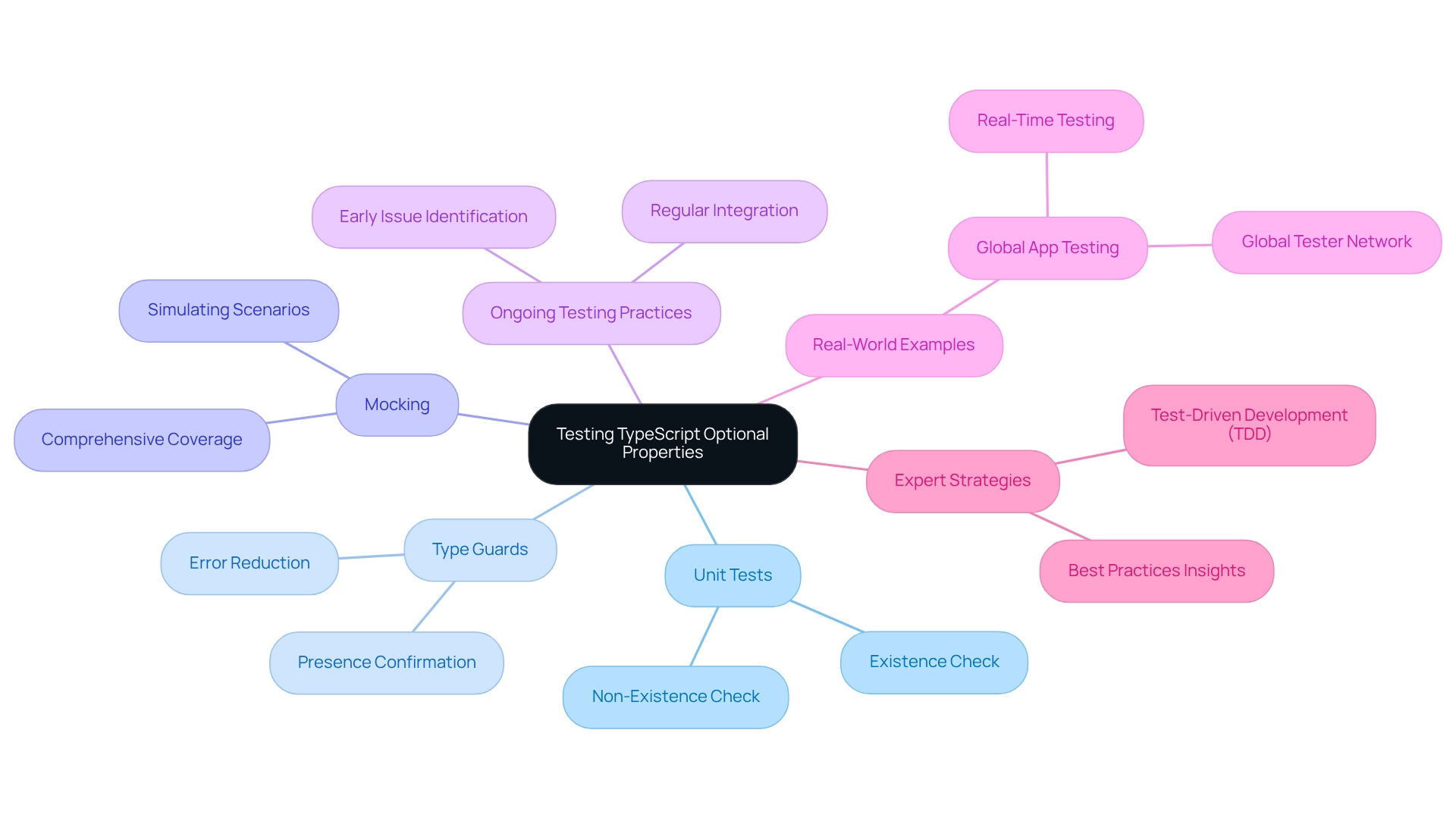
Integrating Optional Properties with Strict Null Checks in TypeScript: Enhancing Type Safety
In programming, developers often encounter challenges with managing TypeScript type optional properties, especially when strict null checks are enabled. This requires explicit handling of scenarios where these properties might be absent. For instance, consider the following code snippet:
interface User {
name: string;
age?: number;
}
function printUser(user: User) {
console.log(`Name: ${user.name}`);
if (user.age !== undefined) {
console.log(`Age: ${user.age}`);
}
}
In this example, the function checks if age is undefined before accessing it, ensuring compliance with strict null checks and maintaining type safety. This practice is essential, particularly as the adoption of strict null checks and the use of TypeScript type optional properties in TypeScript projects continues to grow. Statistics reveal that developers can fix approximately 600 null/undefined errors in less than a day, showcasing the efficiency gained from these practices.
Furthermore, a notable case study illustrates the effectiveness of the ts-migrate tool, which aids in the gradual transition of existing projects to strict null checks. This tool identifies errors and enables developers to refactor their code incrementally, ensuring that new code paths immediately benefit from enhanced type safety. By integrating additional features with strict null checks, developers can refine their coding practices, leading to more resilient and error-free applications. Are you ready to elevate your coding standards?

The Future of Optional Properties in TypeScript: Trends and Predictions
As TypeScript evolves, developers face significant challenges with the typescript type optional property. Future versions are anticipated to enhance typescript type optional property security by introducing more stringent rules for non-mandatory attributes. This shift aims to reduce runtime errors and align with the broader goal of improving reliability and maintainability.
Furthermore, the introduction of novel utility types is on the horizon, designed to simplify the management of non-mandatory features. These advancements will empower developers to write more flexible and maintainable code, ultimately boosting productivity.
In addition, as the TypeScript community grows, best practices surrounding non-mandatory features will continue to develop. This evolution will provide developers with a wealth of resources and guidelines, promoting effective usage and adherence to industry standards. Notably, understanding the demographics of JavaScript developers, predominantly aged between 25 and 34, can help tailor these best practices to a diverse audience.
Similarly, as the ECMAScript proposal for non-mandatory type annotations progresses, currently at stage 1, it is expected to gradually influence JavaScript development practices. This will foster a culture of type safety and robust coding standards.
Moreover, developers are already witnessing improved type safety in projects utilizing typed programming languages. Instances where TypeScript type optional properties are utilized demonstrate the practical advantages of integrating these features in real-world scenarios.
Looking ahead to 2025, the evolution of the TypeScript type optional property is projected to reflect a deeper integration of type safety principles. The focus will be on mitigating common pitfalls associated with JavaScript's dynamic nature, leading to a more standardized approach to coding practices across the community. As Jigar Agrawal insightfully noted, "By monitoring JavaScript statistics and trends closely, you will be in a better position to gain a competitive threshold in the industry; adopt new technology, and take advantage of new opportunities for innovation." This underscores the importance of staying informed about TypeScript developments and trends.
Conclusion
The challenges developers face in coding can often feel overwhelming. However, the exploration of optional properties in TypeScript reveals their vital role in enhancing code flexibility and maintainability. By allowing developers to define properties that may or may not be present, TypeScript facilitates the creation of adaptable code structures that cater to a variety of use cases. This adaptability not only simplifies complex data management but also improves overall code quality.
Furthermore, tools like Kodezi significantly bolster these efforts by automating code generation and adhering to best practices. This shift ultimately leads to increased productivity and efficiency, allowing developers to focus more on building features rather than getting mired in repetitive tasks. As developers embrace such innovations, they can reflect on how these tools align with their coding practices.
In addition, mastering optional properties and leveraging tools that enhance development practices are essential for any developer aiming to thrive in the modern software development environment. The future of TypeScript promises further advancements that will solidify the significance of optional properties in creating resilient, efficient, and user-friendly applications. Staying informed and adaptable will be key to harnessing the full potential of TypeScript and improving application quality. Explore the tools available on Kodezi to elevate your coding experience.
Frequently Asked Questions
What challenges do developers face when coding with APIs?
Developers often struggle with managing complex API specifications, which can complicate the coding process.
How does Kodezi help developers with API specifications?
Kodezi offers an OpenAPI Specification Generator that automates the generation of TypeScript scripts from API specifications, streamlining the development process.
What are the benefits of automating TypeScript script generation?
Automating script generation allows developers to focus on creating features instead of repetitive tasks, leading to enhanced productivity and improved work quality.
What feature does Kodezi CLI provide to improve code quality?
Kodezi CLI includes an AutoHeal feature that swiftly identifies and rectifies codebase issues before every push, ensuring high coding standards and security practices.
How does Kodezi impact developer efficiency?
The integration of automated code generation tools like Kodezi significantly boosts developer efficiency, enabling teams to deliver high-quality applications more rapidly.
What are TypeScript type optional properties?
TypeScript type optional properties allow developers to define attributes in object structures that may or may not exist, indicated by the question mark (?) syntax.
Why are optional properties important in TypeScript?
Optional properties enhance code flexibility and adaptability, allowing developers to create structures that can accommodate various use cases without rigid requirements.
What best practices should developers follow when using TypeScript type optional properties?
Developers should use clear names for attributes, limit usage of non-essential features, document behavior, combine optional properties with default values, utilize type inference, implement readonly index signatures, collect developer input, include practical illustrations, stay informed with industry standards, and emphasize documentation significance.
How can Kodezi assist with managing optional properties in TypeScript?
Kodezi's tools help developers efficiently manage additional attributes, including TypeScript type optional properties, thereby improving productivity and code quality.




